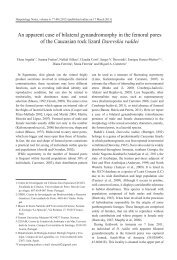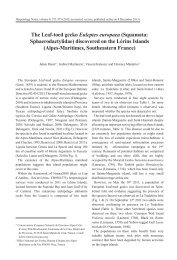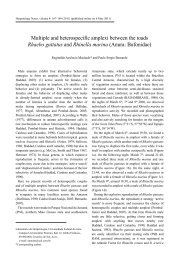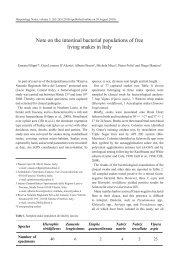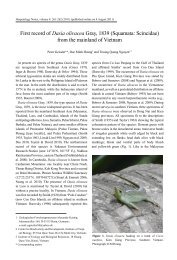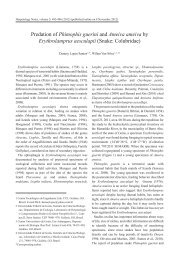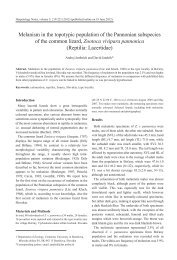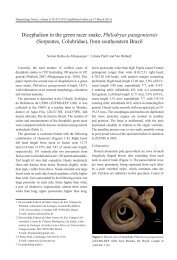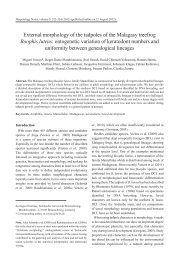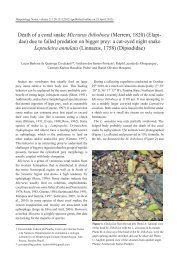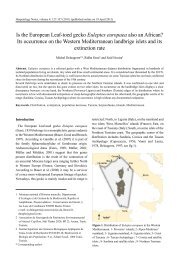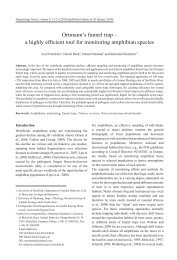from Alto Alegre dos Parecis, southwestern Amazonia, Brazil
from Alto Alegre dos Parecis, southwestern Amazonia, Brazil
from Alto Alegre dos Parecis, southwestern Amazonia, Brazil
Create successful ePaper yourself
Turn your PDF publications into a flip-book with our unique Google optimized e-Paper software.
Herpetology Notes, volume 5: 473-480 (2012) (published online on 12 October 2012)<br />
Checklist of reptiles (Testudines, Squamata) <strong>from</strong> <strong>Alto</strong> <strong>Alegre</strong> <strong>dos</strong><br />
<strong>Parecis</strong>, <strong>southwestern</strong> <strong>Amazonia</strong>, <strong>Brazil</strong><br />
Introduction<br />
Miquéias Ferrão 1,* , José Alexandre Soares Rodrigues Filho 2 and Mitzi Oliveira da Silva 3<br />
Abstract. We present a list of reptiles <strong>from</strong> <strong>Alto</strong> <strong>Alegre</strong> <strong>dos</strong> <strong>Parecis</strong>, state of Rondônia, northern <strong>Brazil</strong>, within <strong>southwestern</strong><br />
<strong>Amazonia</strong>, and discuss possible effects of the approval of a new <strong>Brazil</strong>ian Forest Code on the local reptile fauna. Specimens<br />
were collected in 2007 through time-constrained search, occasional encounters, collection by third parties, and pitfall traps. We<br />
recorded 38 reptile species in the study area, distributed into two orders (Testudines, and Squamata) and 13 families: Chelidae<br />
(one), Polychrotidae (three), Tropiduridae (one), Gekkonidae (one), Sphaerodactylidae (three), Teiidae (one), Gymnophthalmidae<br />
(one), Scincidae (one), Anillidae (one), Boidae (three), Colubridae (18), Elapidae (two), and Viperidae (two). Records of the<br />
snakes Dipsas variegata and Pseudoboa nigra represent the third and the second formal records of these species, respectively, for<br />
the state of Rondônia.<br />
Keywords. reptiles, Amazon, <strong>Brazil</strong>ian Forest Code, conservation.<br />
Approximately 732 reptile species occur in <strong>Brazil</strong><br />
(Bérnils and Costa, 2011), of which 273 species are<br />
recorded <strong>from</strong> <strong>Amazonia</strong>, including 16 chelonians,<br />
four crocodilians, 104 snakes, and 149 lizards (Ávila-<br />
Pires, Hoogmoed and Vitt, 2007). Due to the inventories<br />
carried out in new areas and to the description of<br />
new species in the past few years, the number of<br />
reptile species that occur in <strong>Amazonia</strong> has been<br />
constantly increasing (França and Venancio, 2010).<br />
Among studies on reptile assemblages in the state of<br />
Rondônia stand out those carried out along the road<br />
BR-364 (Vanzolini, 1986; Nascimento, Avila-Pires and<br />
Cunha, 1988) and in the municipalities of Espigão do<br />
Oeste (Bernarde and Abe, 2006; Macedo, Bernarde<br />
and Abe, 2008), Cacoal (Turci and Bernarde, 2008),<br />
Guajará-Mirim (Avila-Pires et al., 2009), and Candeias<br />
do Jamari (Silva-Jr, 1993). Rapid biological inventories<br />
were carried in Pimenta Bueno (Yuki, Galatti and<br />
Rocha, 1999) and Costa Marques (Brandão, 2002).<br />
Gainsbury and Colli (2003) studied the ecology of lizard<br />
1 Programa de Pós-Graduação em Ecologia e Conservação<br />
da Biodiversidade, Instituto de Biociências, Universidade<br />
Federal do Mato Grosso, Av. Fernando Correa 2367, CEP<br />
78060-900 Cuiabá, Mato Grosso, <strong>Brazil</strong>.<br />
2 Faculdade da Amazônia – FAMA, Rua 743 2043 - CEP<br />
78995-000 Vilhena, Rondônia, <strong>Brazil</strong>.<br />
E-mail: cowboy.bio@hotmail.com<br />
3 Instituto Chico Mendes de Conservação da Biodiversidade,<br />
Avenida Lauro Sodré, 6500 Bairro Aeroporto, CEP 76803-<br />
260 Porto Velho, Rondônia, <strong>Brazil</strong>.<br />
E-mail: mitzi.silva@icmbio.gov.br<br />
*Corresponding author: uranoscodon@gmail.com<br />
assemblages of Cerrado enclaves in Guajará-Mirim,<br />
Pimenta Bueno, and Vilhena. The feeding habits of<br />
snakes in Espigão do Oeste were assessed by Bernarde<br />
and Abe (2010). Despite considerable number of studies<br />
carried out in the state of Rondônia, there are still<br />
many knowledge gaps regarding reptile richness and<br />
diversity in several regions, mainly in the regions more<br />
distant <strong>from</strong> the area of influence of the road BR-364.<br />
Deforestation in <strong>Brazil</strong>ian <strong>Amazonia</strong> has been<br />
continuously increasing since 1991, varying in time<br />
according to changes in economical pressures (Fearnside,<br />
2001; 2006). Causes of accelerated deforestation in the<br />
Amazon are several and include expansion of cattle<br />
farming, logging, and agriculture (Fearnside, 2001).<br />
In 2003, deforested areas covered 16% of <strong>Amazonia</strong><br />
and were more expressive in the ‘deforestation<br />
arch’, a large region that extends <strong>from</strong> Rondônia to<br />
Maranhão (Ferreira, Venticinque and Almeida, 2005).<br />
Rondônia is one of the <strong>Brazil</strong>ian states that deforest the<br />
most (Ferreira, Venticinque and Almeida, 2005); small<br />
farmers are one of the main agents of deforestation<br />
(Fearnside, 2006). Because of the intensive deforestation<br />
that Rondônia undergoes, the state has been suggested<br />
as a region of high interest for herpetofauna studies<br />
(Vogt, Moreira and Duarte, 2001). These studies are of<br />
fundamental importance, and may help in the decision<br />
making related to conservation (e.g. creation of reserves).<br />
The old <strong>Brazil</strong>ian Forest Code (Federal Law nº 4.771,<br />
15th September 1965) was known to be restrictive<br />
and conservative concerning the conservation and<br />
maintenance of the environment. However, a new<br />
<strong>Brazil</strong>ian Forest Code (Federal Law nº 12.651,<br />
25th may 2012) was approved in 2012. Several<br />
are the changes in the new code, among them: (1)
474<br />
Figure 1. Location of the municipality of <strong>Alto</strong> <strong>Alegre</strong> <strong>dos</strong> <strong>Parecis</strong> (triangle), state of Rondônia, <strong>Brazil</strong>.<br />
possibility of reduction of the legal reserve (LR)<br />
in many areas of <strong>Amazonia</strong> <strong>from</strong> 80% to 50%; (2)<br />
permission to reforest LR areas with exotic species.<br />
Due to the intensive deforestation in Rondônia<br />
and the lack of knowledge regarding composition<br />
of the reptile fauna in several regions of this state,<br />
we present here the species list of a locality in the<br />
municipality of <strong>Alto</strong> <strong>Alegre</strong> <strong>dos</strong> <strong>Parecis</strong>, <strong>Brazil</strong> and<br />
briefly discuss possible effects of the approval of<br />
the new forest code on the local reptile assemblage.<br />
Materials and Methods<br />
The study was carried out in Santa Rita Farm (12º07’ S, 61º51’<br />
W), located in the municipality of <strong>Alto</strong> <strong>Alegre</strong> <strong>dos</strong> <strong>Parecis</strong>, state<br />
of Rondônia, <strong>Brazil</strong>, <strong>southwestern</strong> Amazon (Fig. 1). The region<br />
of <strong>Alto</strong> <strong>Alegre</strong> <strong>dos</strong> <strong>Parecis</strong> comprises several kinds of vegetation,<br />
such as submontane open rainforest, open lowland rainforest,<br />
open savanna forest, submontane semideciduous seasonal forest,<br />
as well as areas of ecological tension of savanna/rainforest.<br />
The vegetation of the Santa Rita Farm consists of secondary<br />
rainforest and deforested area (pasture), forming a fragmented<br />
landscape. It is under the influence of the mountain range Serra<br />
<strong>dos</strong> <strong>Parecis</strong> in the state of Mato Grosso. Annual rainfall in the<br />
municipality varies annually between 1,400 mm and 1,800<br />
mm. Dry season occurs <strong>from</strong> June to August, rainy season<br />
Miquéias Ferrão et al.<br />
<strong>from</strong> December to May. Average air temperature is 25 °C.<br />
Reptile sampling was carried out between January 2007 and<br />
May 2007, with sporadic collections between June 2007 and<br />
December 2007. Specimens were captured through four methods:<br />
(1) time-constrained search (Campbell and Christman, 1982); (2)<br />
occasional encounters (Martins and Oliveira, 1998); (3) collection<br />
by third parties (see Cunha and Nascimento, 1993); and (4) pitfall<br />
traps with drift fences (Campbell and Christman, 1982; Cechin<br />
and Martins, 2000). Pitfalls were divided into four groups, three<br />
in secondary forest and one in deforested area (pasture). Each<br />
group containing four recipients of 60 L, 10 m apart <strong>from</strong> each<br />
other, arranged in a straight line and united by a plastic canvas of<br />
approximately 1 m height. Traps remained opened for three days<br />
each month <strong>from</strong> January to April 2007, summing up 60 pitalls.day.<br />
For identifying reptiles we used keys and descriptions by Peters<br />
and Orejas-Miranda (1970), Cunha and Nascimento (1993), Silva-<br />
Jr (1993), Ávila-Pires (1995), Roze (1996), and Zaher (1996).<br />
Nomenclature of Colubroidea followed Pyron et al. (2011).<br />
Voucher specimens were deposited in the Zoological Collection of<br />
Vertebrates of the Federal University of Mato Grosso (Universidade<br />
Federal de Mato Grosso – UFMT), Cuiabá, and in Capão da<br />
Imbuia Natural History Museum, Curitiba, Paraná, <strong>Brazil</strong>.<br />
Results and Discussion<br />
We recorded 38 reptile species in Santa Rita Farm,<br />
distributed in three orders and 13 families: Chelidae (1),
Checklist of reptiles <strong>from</strong> <strong>Alto</strong> <strong>Alegre</strong> <strong>dos</strong> <strong>Parecis</strong> 475<br />
Polychrotidae (3), Tropiduridae (1), Gekkonidae (1),<br />
Sphaerodactylidae (3), Teiidae (1), Gymnophthalmidae<br />
(1), Scincidae (1), Anillidae (1), Boidae (3), Colubridae<br />
(18), Elapidae (2), and Viperidae (2).<br />
The number of species recorded exclusively in forest<br />
environments (secondary forest and water environment<br />
in forest) and anthropic environments (human<br />
edification, pasture and water environment in deforested<br />
area) accounted for approximately 61% and 16% of<br />
total species sampled, respectively (Tab. 1).<br />
Based on the current knowledge of the geographic<br />
distribution of reptiles in Rondônia (Vanzolini, 1986;<br />
Nascimento, Ávila-Pires and Cunha, 1988; Silva-<br />
Jr. 1993; Yuki, Galatti and Rocha, 1999; Brandão,<br />
2002; Bernarde and Abe 2006; Turci and Bernarde,<br />
2008; Avila-Pires et al., 2009), we expected the sub-<br />
Figure 2. Lizard species recorded <strong>from</strong> Santa Rita Farm, <strong>Alto</strong> <strong>Alegre</strong> <strong>dos</strong> <strong>Parecis</strong>, state of Rondônia, <strong>southwestern</strong> <strong>Amazonia</strong>,<br />
<strong>Brazil</strong>. A- Gonatodes humeralis; B- Chatogekko amazonicus; C- Anolis ortonii; D- Uranoscodon superciliosus; E- Cercosaura<br />
eigenmani (male); F- Cercosaura eigenmani (female). Photos: Miquéias Ferrão (A, B, C, D); Adriano M. Silva (E, F).
476<br />
Miquéias Ferrão et al.<br />
Figure 3. Snake species recorded in Santa Rita Farm, <strong>Alto</strong> <strong>Alegre</strong> <strong>dos</strong> <strong>Parecis</strong>, state of Rondônia, <strong>southwestern</strong> <strong>Amazonia</strong>, <strong>Brazil</strong>.<br />
A- Xenodon severus (juvenile); B- Liophis reginae; C- Leptodeira annulata; D- Mastigodryas boddaerti (juvenile); E- Leptophis<br />
ahaetulla; F- Corallus hortulanus; G- Philodryas viridissima; H- Boa constrictor. Photos: Miquéias Ferrão (A, B, C, D, H); Aldes<br />
Lamounier (E); Adriano M. Silva (F, G).
Checklist of reptiles <strong>from</strong> <strong>Alto</strong> <strong>Alegre</strong> <strong>dos</strong> <strong>Parecis</strong> 477<br />
Table 1. Species of reptiles recorded in Santa Rita Farm, <strong>Alto</strong> <strong>Alegre</strong> <strong>dos</strong> <strong>Parecis</strong>, state of Rondônia, <strong>southwestern</strong> <strong>Amazonia</strong>,<br />
<strong>Brazil</strong>. Habitat FO = secondary forest; HE = human edification; NF = edge secondary forest; PA = deforested area (pasture);<br />
WE1 = water environment in forest; WE2 = water environment in deforested area.<br />
ORDER/FAMILY SPECIES HABITAT<br />
TESTUDINES<br />
Chelidae<br />
SQUAMATA<br />
Polychrotidae<br />
Tropiduridae<br />
Gekkonidae<br />
Sphaerodactylidae<br />
Teiidae<br />
Gymnophthalmidae<br />
Scincidae<br />
Anillidae<br />
Boidae<br />
Colubridae<br />
Elapidae<br />
Viperidae<br />
<br />
Platemys platycephala (Schneider, 1792) WE 1<br />
Anolis fuscoauratus D´Orbigny, 1837 FO<br />
Anolis ortonii Cope, 1869 FO<br />
Anolis transversalis Duméril, 1851 FO<br />
Uranoscodon superciliosus (Linnaeus, 1758) FO<br />
Hemidactylus mabouia (Moreau de Jonnès, 1818) HE<br />
Chatogekko amazonicus (Andersson, 1918) FO<br />
Gonatodes hasemani Griffin, 1917 FO<br />
Gonatodes humeralis (Guichenot, 1855) FO<br />
Ameiva ameiva (Linnaeus, 1758) PA; HE<br />
Cercosaura eigenmani (Griffin, 1917) FO<br />
Mabuya nigropunctata (Spix, 1825) FO<br />
Anilius scytale (Linnaeus, 1758) WE 1<br />
Boa constrictor Linnaeus, 1758 FO<br />
Corallus hortulanus (Linnaeus, 1758) FO; NF<br />
Eunectes murinus (Linnaeus, 1758) WE 2<br />
Clelia plumbea (Wied, 1820) PA<br />
Dipsas catesbyi (Sentzen, 1796) FO<br />
Dipsas indica Laurenti, 1768 FO<br />
Dipsas variegata (Duméril, Bibron & Duméril, 1854) NF<br />
Drymarchon corais (Boie, 1827) PA<br />
Helicops angulatus (Linnaeus, 1758) WE 2<br />
Imantodes cenchoa (Linnaeus, 1758) FO<br />
Leptodeira annulata (Linnaeus, 1758) FO; NF<br />
Leptophis ahaetulla (Linnaeus, 1758) FO<br />
Liophis reginae (Linnaeus, 1758) FO<br />
Mastigodryas boddaerti (Sentzen, 1796) FO; PA<br />
Oxybelis aeneus (Wagler, 1824) FO<br />
Oxyrhopus melanogenys (Tschudi, 1845) FO<br />
Philodryas viridissima (Linnaeus, 1758) NF<br />
Pseudoboa nigra (Duméril, Bibron & Duméril, 1854) NF; PA<br />
Rhinobothryum lentiginosum (Scopoli, 1785) FO<br />
Xenodon severus (Linnaeus, 1758) FO; NF<br />
Xenopholis scalaris (Wucherer, 1861) NF<br />
Micrurus lemniscatus (Linnaeus, 1758) FO<br />
Micrurus surinamensis (Cuvier, 1817) WE 1<br />
Bothrops atrox (Linnaeus, 1758) FO; NF<br />
Lachesis muta (Linnaeus, 1766) FO
478<br />
arboreal snakes Chironius exoletus, C. scurrulus,<br />
Spilotes pullatus, and Philodryas olfersii, the fossorial/<br />
cryptozoic snakes Atractus albuquerquei, Typhlops<br />
reticulatus, and Tantilla melanocephala, and the<br />
terricolous snake Epicrates cenchria in <strong>Alto</strong> <strong>Alegre</strong> <strong>dos</strong><br />
<strong>Parecis</strong>, which were not sampled. The lizards Iguana<br />
iguana, Anolis punctatus, Plica spp., Tupinambis sp.,<br />
Cercosaura ocellata, Leposoma spp. and the chelonian<br />
Chelonoidis denticulata were expected to occur in the<br />
region, since local residents reported observing these<br />
species. Further reptile inventories in the region of <strong>Alto</strong><br />
<strong>Alegre</strong> <strong>dos</strong> <strong>Parecis</strong> with larger sampling effort and the<br />
use of additional capture methods (e.g., entomological<br />
nets and funnel-traps) will probably reveal several other<br />
species. Additionally, new sampling in areas of primary<br />
forests should reveal species not registered in this study,<br />
once primary environments have a greater diversity of<br />
reptile species (Gardner et al., 2007).<br />
Dipsas variegata has been recorded in the Guyana,<br />
French Guiana, Suriname, Venezuela, Peru, Colombia,<br />
Ecuador, <strong>Brazil</strong> (Cunha and Nascimento, 1993), and<br />
Bolívia (Harvey and Embert, 2008). According to<br />
Harvey and Embert (2008), Dipsas variegata commonly<br />
occurs only in the Guianas, but isolated populations may<br />
occur all over the Amazon. One of these populations<br />
was found in Rondônia. Harvey and Embert (2008)<br />
recognize as Dipsas variegata the specimen captured<br />
in Guajará-Mirim State Park, mentioned later by Avila-<br />
Pires et al. (2009). Passos, Fernandes and Caramaschi<br />
(2004) reported one specimen in the municipality of<br />
Porto Velho. The specimen collected in the present<br />
study is the third record for the state of Rondônia and<br />
is approximately 400 and 435 km away <strong>from</strong> Guajará-<br />
Mirim and Porto Velho, respectively, where the two<br />
previous records were made. According to Harvey and<br />
Embert (2008), populations of Dipsas variegata occur<br />
together with populations of Dipsas indica and Dipsas<br />
catesbyi, as observed in <strong>Alto</strong> <strong>Alegre</strong> <strong>dos</strong> <strong>Parecis</strong>.<br />
In Rondônia, Pseudoboa nigra was recorded in<br />
Guajará-Mirim by França, Mesquita and Colli (2006),<br />
in a checklist of the snakes of <strong>Amazonia</strong>n savannas.<br />
Two individuals were captured in Santa Rita Farm,<br />
which is located approximately 400 km away <strong>from</strong> the<br />
locality where the species was sampled for the first time,<br />
representing the second record of Pseudoboa nigra for<br />
the state of Rondônia.<br />
<strong>Alto</strong> <strong>Alegre</strong> <strong>dos</strong> <strong>Parecis</strong> had until 2006 a total of 28.36%<br />
of its native areas deforested (Secretaria de estado do<br />
Desenvolvimento Ambiental – Rondônia, 2009). Due<br />
to the intensive deforestation in this municipality, many<br />
areas need to be reforested. The new <strong>Brazil</strong>ian Forest<br />
Code allows these areas could be reforested with exotic<br />
species (e.g., Eucalyptus spp. and Pinus spp.). Altered<br />
environments with exotic vegetation sustain a lower<br />
reptile diversity than natural environments (Marques<br />
and Sazima, 2004; Macedo, Bernarde and Abe, 2008;<br />
Gardner et al., 2007), dominated by generalist species<br />
with widespread distributions. According to Marques et<br />
al. (2010), large part of <strong>Brazil</strong>ian reptiles cannot survive<br />
in altered environments by human activities (including<br />
exotic species forests). Recolonization of areas<br />
reforested with exotic species by forest reptiles, mainly<br />
the ones of arboreal or semi-arboreal habits (e.g. Anolis<br />
spp., Corallus hortulanus, Dipsas spp., Imantodes<br />
cenchoa, Leptodeira annulata, Philodryas viridissima,<br />
and Oxybelis aeneus) would be hindered.<br />
The exigencies of the new <strong>Brazil</strong>ian Forest Code are<br />
excessively liberal and abusive, and are reproachable<br />
in terms of generalization (Ab’Saber, 2010). Represent<br />
an immensurable risk to the biological and genetic<br />
heritage (Metzger, 2010). Many changes should be<br />
carried out in the new <strong>Brazil</strong>ian Forest Code so that it<br />
meets the interests of conservation and agribusiness in a<br />
sustainable way, without threatening the rich <strong>Brazil</strong>ian<br />
biodiversity.<br />
Acknowledgements. We thank José Alexandre Rodrigues Soares<br />
and Ivone Maria Posse for allowing us to collect in Santa Rita<br />
Farm. Francisca Cândida de Assis gave us logistic support.<br />
Christine Strüssmann made the first reading of this manuscript<br />
and gave us invaluable suggestions. Lilian Cristina Macedo,<br />
Weslei Valteran <strong>dos</strong> Santos, Adriano Martins and Valquiria<br />
Selhorst helped us in the fieldwork. Júlio César de Moura Leite<br />
identified the specimens of Pseudoboa nigra and Philodryas<br />
viridissima. Pedro Ivo Simões made the map of the study area.<br />
CAPES (Coordenação de Aperfeiçoamento de Pessoal de Nível<br />
Superior) granted MF a scholarship.<br />
References<br />
Miquéias Ferrão et al.<br />
Ab’Saber, A.N. (2010): Evolving <strong>from</strong> a Forest Code to a Biodiversity<br />
Code. Biota Neotropica 10(4): 331-335.<br />
Ávila-Pires, T.C.S. (1995): Lizards of <strong>Brazil</strong>ian <strong>Amazonia</strong> (Reptilia:<br />
Squamata). Zoologische Verhandelingen 299: 1-706.<br />
Ávila-Pires, T.C.S., Hoogmoed, M.S., Vitt, L.J. (2007): Herpetofauna<br />
da Amazônia. In: Herpetologia do Brasil II, p.13-43.<br />
Nascimento, L.B., Oliveira, M.E. Eds, Belo Horizonte, Sociedade<br />
Brasileira de Herpetologia.<br />
Ávila-Pires, T.C.S., Vitt, L.J., Sartorius, S.S., Zani, P.A. (2009):<br />
Squamata (Reptilia) <strong>from</strong> four sites in southern <strong>Amazonia</strong>,<br />
with a biogeographic analysis of <strong>Amazonia</strong>n lizards. Boletim<br />
do Museu Paraense Emílio Goeldi, Ciências Naturais 4(2), 99-<br />
118.
Checklist of reptiles <strong>from</strong> <strong>Alto</strong> <strong>Alegre</strong> <strong>dos</strong> <strong>Parecis</strong> 479<br />
Bernarde, P.S., Abe, A.S. (2006): A snake community at Espigão<br />
do Oeste, Rondônia, Southwestern Amazon, <strong>Brazil</strong>. South<br />
American Journal of herpetology 1(2): 102-113.<br />
Bernarde, P.S., Abe, A. (2010): Hábitos alimentares de serpentes<br />
em Espigão do Oeste, Rondônia, Brasil. Biota Neotropica<br />
10(1). Available at: http://www.biotaneotropica.org.br/v10n1/<br />
en/abstract?article+bn02510012010. Last accessed on 02<br />
January 2012.<br />
Bérnils, R.S., Costa, H.C. (Org.) (2011): <strong>Brazil</strong>ian reptiles – List<br />
of species, Sociedade Brasileira de Herpetologia. Available at:<br />
http://www.sbherpetologia.org.br/. Last accessed on 07 January<br />
2012.<br />
Brandão, R. A. (2002): Avaliação ecológica rápida da herpetofauna<br />
nas reservas extrativistas de Pedras Negras e Curralinho,<br />
Costa Marques, RO. Brasil Florestal 74: 61-73.<br />
Campbell, H.W., Christman, S.P. (1982): Filed techniques for herpetofaunal<br />
community analisys. In: Herpetological communities:<br />
a Symposium of the Society for the Study of Amphibians<br />
and Reptiles and the Herpetologist’ League, p.193-200. Scott,<br />
N.J.Jr, Ed., Washington, U.S. Fish Wildlife Service.<br />
Cechim, S.Z., Martins, M. (2000): Eficiência de armadilhas de<br />
queda (pitfall traps) em amostragem de anfíbios e répteis no<br />
Brasil. Revista Brasileira de Zoologia 17(3): 729-740.<br />
Cunha, O.R., Nascimento, F.P. (1993): Ofídios da Amazônia. As<br />
cobras da região Leste do Pará. Boletim do Museu Paraense<br />
Emílio Goeldi, Zoologia 9: 1-191.<br />
Fearnside, P.M. (2001): Soybean cultivation as a threat to the environment<br />
in <strong>Brazil</strong>. Environmental Conservation 28: 23-38.<br />
Fearnside, P. M. (2006): Desmatamento na Amazônia: dinâmica,<br />
impactos e controle. Acta Amazonica 36(3): 395-400.<br />
Ferreira, L.V., Venticinque, E., Almeida, S. (2005): O desmatamento<br />
na Amazônia e a importância das áreas protegidas. Estu<strong>dos</strong><br />
Avança<strong>dos</strong> 19(53): 157-166.<br />
França, F.G.R, Mesquita, D.O., Colli, G.R. (2006): A checklist<br />
of snakes <strong>from</strong> <strong>Amazonia</strong>n savannas in <strong>Brazil</strong>, housed in the<br />
coleção herpetológica da universidade de brasília, with new<br />
distribution records. Occasional Papers Sam Noble Oklahoma<br />
Museum of Natural History 17:1–13.<br />
França, F.G.R., Venâncio, N.M. (2010): Reptiles and amphibians<br />
of a poorly known region in southwest <strong>Amazonia</strong>. Biotemas<br />
23(3): 71-84.<br />
Gainsbury, A.M., Colli, G.R. (2003): Lizard assemblages <strong>from</strong><br />
natural enclaves in Southwestern Amazônia: the role of stochastic<br />
extinctions and isolation. Biotropica 35(4): 503-519.<br />
Gardner, T.A., Ribeiro, M.A. Jr, Barlow, J., Ávila-Pires, T.A.S.,<br />
Hoogmoed, M., Peres, C.A. (2007): The value of primary, secondary<br />
and plantation forests for a neotropical herpetofauna.<br />
Conservation Biology 21: 775–787.<br />
Harvey, M.B., Embert, D. (2008): Review of Bolivian Dipsas<br />
(Serpentes: Colubridae), with comments on other South American<br />
species. Herpetological Monographs 22: 54-105<br />
Macedo, L.C., Bernarde, P.S., Abe, A.S. (2008): Lagartos (Squamata:<br />
Lacertilia) em áreas de floresta e de pastagem em<br />
Espigão do Oeste, Rondônia, sudoeste da Amazônia, Brasil.<br />
Biota Neotropica 8(1): 133-139.<br />
Marques, O.A.V., Nogueira, C., Martins, M., Sawaya, R.J. (2010):<br />
Potential impacts of changes in the <strong>Brazil</strong>ian Forest Code on<br />
reptiles. Biota Neotropica, 10(4). Available at: http://www.<br />
biotaneotropica.org.br/v10n4/en/abstract?article+bn00510042<br />
010. Last accessed on 10 January 2012.<br />
Marques, O.A.V., Sazima, I. (2004): História natural <strong>dos</strong> répteis da<br />
Estação Ecológica Juréia-Itatins. In: Estação Ecológica Juréia-<br />
Itatins: ambiente físico, flora e fauna, p. 257-277. Marques,<br />
O.A.V., Duleba, W., Eds. Ribeirão Preto, Holos Editora.<br />
Martins, M., Oliveira, M.E. (1998): Natural history of snakes in<br />
forests of the Manaus region, Central <strong>Amazonia</strong>, <strong>Brazil</strong>. Herpetological<br />
Natural History 6: 78-150.<br />
Metzger, J.P. (2010): O Código Florestal tem base científica?<br />
Conservação e Natureza 8: 92-99.<br />
Nascimento, F.P., Ávila-Pires, T.C.S., Cunha, O.R. (1988):<br />
Répteis Squamata de Rondônia e Mato Grosso coleta<strong>dos</strong> através<br />
do programa Polonoroeste. Boletim do Museu Paraense<br />
Emílio Goeldi, Zoologia 4(1): 21-66.<br />
Passos, P., Fernandes, D.S., Caramaschi, U. (2004): The taxonomic<br />
status of Leptognathus incertus Jan, 1863, with revalidation<br />
of Dipsas alternans (Fischer, 1885) (Serpentes: Colubridae:<br />
Dipsadinae). Amphibia-Reptilia (Leiden) 25: 381–393.<br />
Peters, J.A., Orejas-Miranda, B. (1970): Catalogue of the Neotropical<br />
Squamata: Part I, Snakes. Washington, Smithsonian.<br />
Pyron, R.A., Burbrink, F.T., Colli, G.R., Montes de Oca, A.N.,<br />
Vitt, L.J., Kuczynski, C.A., Wiens, J.J. (2011): The phylogeny<br />
of advanced snakes (Colubroidea), with discovery of a new<br />
subfamily and comparison of support methods for likelihood<br />
trees. Molecular Phylogenetics and Evolution 58 (2011): 329-<br />
342.<br />
Roze, J.A. (1996): Coral snakes of the Americas: biology, identification,<br />
and venoms. Florida, Krieger Publishing company.<br />
Secretaria do Estado de Desenvolvimento Ambiental - Rondônia.<br />
(2009): Plano de prevenção, controle e alternativas sustentáveis<br />
ao desmatamento em Rondônia. Porto Velho, SEDAM.<br />
Silva-Jr., N.J. (1993): The snakes <strong>from</strong> Samuel hydroelectric<br />
power plant and vicinity, Rondônia, <strong>Brazil</strong>. Herpetological<br />
Natural History 1: 873-901.<br />
Turci, L.C.B., Bernarde, P.S. (2008): Levantamento herpetofaunístico<br />
em uma localidade no município de Cacoal, Rondônia,<br />
Brasil. Biooikos 22(2): 101-108.<br />
Vanzolini, P.E. (1986): Levantamento herpetológico da área<br />
do Estado de Rondônia sob a influência da rodovia Br-364.<br />
Brasília, CNPq/Polonoroeste/Ecologia Animal.<br />
Vogt, R.C., Moreira, G., Duarte, A.C.O.C. (2001): Biodiversidade<br />
de répteis do bioma floresta Amazônica e ações prioritárias<br />
para sua conservação. In: Biodiversidade na Amazônia brasileira:<br />
avaliação e ações prioritárias para a conservação, uso<br />
sustentável e repartição de benefícios, p. 89-86. Capobianco,<br />
J.P.R. Org., São Paulo, Instituto Sócio Ambiental.<br />
Yuki, R.N., Galatti, U., Rocha, M.T. (1999): Contribuições ao<br />
conhecimento da fauna de Squamata de Rondônia, Brasil, com<br />
dois novos registros. Boletim do Museu Paraense Emílio Goeldi,<br />
Zoologia 15: 181-193.<br />
Zaher, H. (1996): A new genus and species of Pseudoboine snake,<br />
with a revision of the genus Clelia (serpents, Xenodontinae).<br />
Bolletino del Museo Regionale di Scienze Naturali Torino<br />
14(2): 289-337.
480<br />
Appendix 1. Voucher list (UFMT – Coleção de Vertebra<strong>dos</strong> da<br />
Universidade Federal de Mato Grosso, Cuiabá, state of Mato Grosso,<br />
<strong>Brazil</strong>; MHNCI – Museu de História Natural Capão da Imbuia,<br />
Curitiba, State of Paraná, <strong>Brazil</strong>).<br />
Ameiva ameiva (UFMT 6911, UFMT 6925), Anilius scytale<br />
(UFMT 6939), Anolis fuscoauratus (UFMT 6920, UFMT 6921,<br />
UFMT 6923, UFMT 6924), Anolis transversalis (UFMT 6914),<br />
Cercosaura eigenmani (UFMT 6934, UFMT 6935, UFMT 6936),<br />
Clelia plumbea (UFMT 7099), Chatogekko amazonicus (UFMT<br />
6931, UFMT 6932, UFMT 6933), Corallus hortulanus (UFMT<br />
7026, UFMT 7044, UFMT 7096), Dipsas catesbyi (UFMT 6938),<br />
Dipsas indica (UFMT 7022), Dipsas variegata (UFMT 6937),<br />
Gonatodes hasemani (UFMT 6915, UFMT 6916, UFMT 6917),<br />
Gonatodes humeralis (UFMT 6918), Helicops angulatus (UFMT<br />
7047, UFMT 7092), Hemidactylus mabouia (UFMT 6922), Imantodes<br />
cenchoa (UFMT 7027), Leptodeira annulata (UFMT 7025,<br />
UFMT 7100), Leptophis ahaetulla (UFMT 7019), Mabuya nigropunctata<br />
(UFMT 6919), Mastigodryas boddaerti (UFMT 6940,<br />
UFMT 7045, UFMT 7046), Liophis reginae (UFMT 7018, UFMT<br />
7021, UFMT 7028, UFMT 7093), Micrurus lemniscatus (UFMT<br />
6944), Micrurus surinamensis (UFMT 6942), Oxybelis aeneus<br />
(UFMT 6941), Oxyrhopus melanogenys (UFMT 7020, UFMT<br />
7024, UFMT 7094, UFMT 7095), Philodryas viridissima (MHNCI<br />
12783), Pseudoboa nigra (MHNCI 12781, MHNCI 12782), Rhinobothryum<br />
lentiginosum (UFMT 6943), Uranoscodon superciliosus<br />
(UFMT 6912, UFMT 6913), Xenodon severus (UFMT 7097,<br />
UFMT 7098), Xenopholis scalaris (UFMT 7023).<br />
Miquéias Ferrão et al.<br />
Accepted by Mirco Solé



